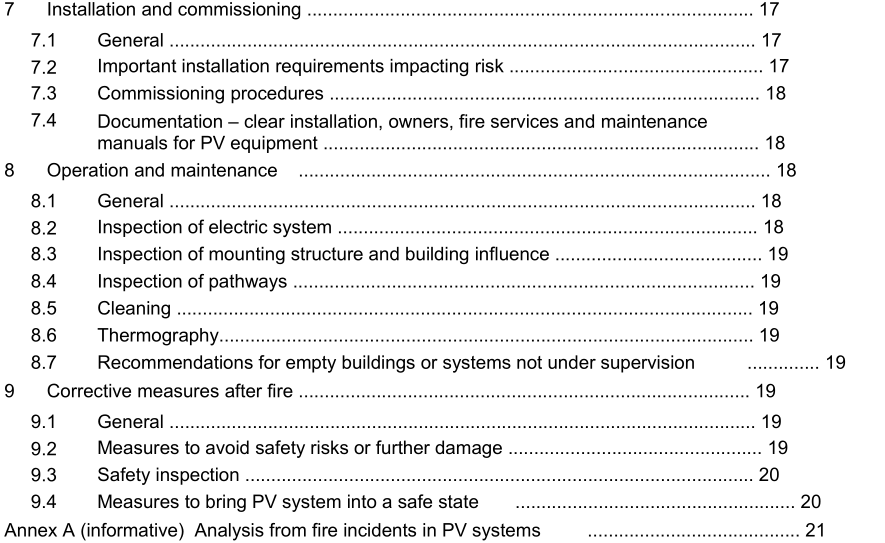IEC TR 63226-2021 pdf Managing fire risk related to photovoltaic (PV) systems on buildings

Roofing materials are tested for certain fire withstand capabilities. However, these product characteristics may not be sufficient to withstand the energy from an arc or fire caused by a fault. If a roofing material is capable of being ignited by an arc or fire caused by a fault, additional measures may be taken into account. Additionally, the presence of PV modules in close proximity to roofing materials may trap or radiate heat from a rooftop fire causing additional roof damage. The higher the fire resistance of the roofing system, the less likely a rooftop fire will cause widespread damage. Depending on the occupancy of the building and the financial risk of loss for the building, it may be necessary to upgrade a roof system’s fire resistance when a PV system is installed on the roof or use additional measures to reduce the fire risk. If the cost of upgrading the fire resistance of the roof or additional equipment is too high, then other installation locations should be considered that require less investment. For buildings covered with exposed flammable roofing materials, additional safety measures should be considered to help prevent fire ignition. Flammable roofing materials include many common roofing materials such as bitumen, asphalt, tar paper, and various polystyrene and polyisocyanurate insulating materials. Higher fire-rated roofing systems that incorporate the most flammable polystyrene insulating materials normally include what is referred to as a cover board between the roof membrane and the insulation to prevent a fire on the membrane from involving the flammable polystyrene materials beneath the membrane. All roofs in Europe – with or without PV – must comply with fire resistance classes according to CEN/TS 1187. There are four different regions with four different tests within Europe.Not only is the roof construction important to the fire risk of a building, the entire building construction is also important. Buildings constructed of concrete, brick, and stone are more fire resistant than steel or wood structures. The concern with building construction types may be accelerated building collapse or propagation of fire to adjacent structures.
- Previous:IEC TR 63250-2021 pdf Household and similar electrical appliances – Method of measuring performance – Assessment of repeatability, reproducibility and uncertainty
- Next:IEC TR 63042-303-2021 pdf UHV AC transmission systems – Part 303: Guideline for the measurement of UHV AC transmission line power frequency parameters
- ISO IEC 27050-4-2021 pdf Information technology — Electronic discovery — Part 4: Technical readiness
- ISO IEC 27036-1-2021 pdf Cybersecurity — Supplier relationships — Part 1: Overview and concepts
- ISO IEC 27013-2021 pdf Information security, cybersecurity and privacy protection — Guidance on the integrated implementation of ISO/IEC 27001 and ISO/IEC 20000-1
- ISO IEC 26580-2021 pdf Software and systems engineering — Methods and tools for the feature- based approach to software and systems product line engineering
- ISO IEC 24735-2021 pdf Information technology — Office equipment — Method for measuring digital copying productivity
- ISO IEC 24711-2021 pdf Information technology — Office equipment — Method for the determination of ink cartridge yield for colour inkjet printers and multi- function devices that contain printer components
- ISO IEC 23544-2021 pdf Information Technology — Data centres — Application Platform Energy Effectiveness (APEE)
- ISO IEC 23510-2021 pdf Information technology — 3D printing and scanning — Framework for an Additive Manufacturing Service Platform (AMSP)
- ISO IEC 23127-1-2021 pdf Information technology — Learning, education, and training — Metadata for facilitators of online learning — Part 1: Framework
- ISO IEC 23126-2021 pdf Information technology for learning, education and training — Ubiquitous learning resource organization and description framework
- IEC 61188-6-2-2021 pdf Circuit boards and circuit board assemblies – Design and use – Part 6-2: Land pattern design – Description of land pattern for the most common surface mounted components (SMD)
- IEC 60205-2009 pdf Calculation of the effective parameters of magnetic piece parts
- IEC TS 63140-2021 pdf Photovoltaic (PV) modules – Partial shade endurance testing for monolithically integrated products
- IEC 62830-5-2021 pdf Semiconductor devices – Semiconductor devices for energy harvesting and generation – Part 5: Test method for measuring generated power from flexible thermoelectric devices
- ISO IEC 17067-2013 pdf Conformity assessment — Fundamentals of product certification and guidelines for product certification schemes
- BS ISO IEC 15420-2009 pdf Information technology一 Automatic identification and data capture techniques EAN/UPC bar code symbology specification
- BS ISO IEC 19762.5-2008 pdf Information technology一 Automatic identification and data capture (AIDC) techniques – Harmonized vocabulary Part 5: Locating systems
- BS IEC 60860-2014 pdf Radiation protection instrumentation一 Warning equipment for criticality accidents
- ISO IEC 24735-2021 pdf Information technology — Office equipment — Method for measuring digital copying productivity
- ISO IEC 24711-2021 pdf Information technology — Office equipment — Method for the determination of ink cartridge yield for colour inkjet printers and multi- function devices that contain printer components